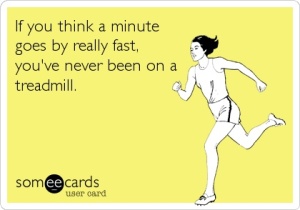
Running is actually far more complicated than one would initially think. Especially if you, like me, hardly did any running for a huge period of your life after childhood and if you don’t participate in sports. Having a break from running and then getting back into it in your adult years – well simply mastering the correct technique for the most efficient movement and speed, and the least wear and tear on the joints can take some practice no wonder there are specialists you can go to just to analyse your running style.
I only started getting into running last year, and at first it was so hard to run outside for even three minutes straight. I used NHS’s free Couch to 5k running podcast program to help me go from 3 min to 20 minutes running straight in a relatively short time and I highly recommend downloading the podcasts if you are new or just getting back into running. http://www.nhs.uk/LiveWell/c25k/Pages/couch-to-5k.aspx
Running it appeals to me for the convenience, no equipment necessary, just put on a good sports bra if you’re a girl, and some supportive sports shoes and out the door you go. It can bring a sense of freedom and a feeling of naturalness few other exercises can replicate.
Beach running is truly one step (if not more) about running on the street. The numerous benefits include:
– The gorgeous landscape and feeling of freedom being near the ocean
– Much less impact on the joints thanks to the absorption effects of the sand
– Not having to worry about being run over by cars
– Strengthens the foot muscles and works into the calves more
– Running without shoes is slightly different from running with shoes and many people would argue is more natural and healthy
If you are new to beach running, take it slowly. Even if you go for runs regularly on the treadmill or the pavements, running with shoes trains you to run in a certain style, and running bear feet will always be a new challenge and work slightly different muscles, so don’t rush into it. I recommend no more than 1-2 times per week for the first month at least. Don’t confuse cardiovascular fitness with readiness for going harder faster – especially when it comes to running we have to remember that our cardiovascular fitness can often develop faster than our tendons, ligaments and muscles can adjust. I should know because I made the mistake of ignoring this advice and paid for it when my knees began hurting and took days to recover 😦 (I backed right off, slowed down, and now am fine. Don’t push through that kind of pain.)
The first time I went for a run on the beach was using a walking/running interval program (the podcasts) for 20 minutes. My Achilles tendon and knees ached a lot the next day and I suspect I was running slightly different from how I do on the pavement and with less support from shoes my feet move differently as well. When you run barefoot and on the sand you have to put more of an emphasis on landing on the ball of your foot, and on floating over the tops of the sand rather than sinking in.
My knees hurt the second week as well, though I recovered quickly (I know just the thing I am trying to avoid by sand running!) But I found this video on youtube and since practising it haven’t had any more pain. It has a series of easy exercises to strengthen your feet and associated leg muscles important for running without shoes and I think that really helped! I recommend when you are getting into this kind of running to give this video a go:
I am really enjoying my weekly beach runs now and would go more often if I could. They are a real treat and give a feeling of connecting with nature, releasing all the stress and tension of the week, forgetting everything and just getting lost in the feeling of the ocean, the sand, the sunset and your feet connected to the ground as they were meant to be – with nothing in between!
Doesn’t that photo just make you want to find the nearest beach and go running along it now? I think I have become a bit addicted to the feeling because I look forward to it all week, and even feel feelings of sadness when i look at those photos and am trapped inside and away from the beach.


 Haha I know this picture definitely applies to some people! Although the majority of the time I’m at the gym the people next to me are just walking on the treadmill not running so there’s isn’t any point in even pretending its a race. :p
Haha I know this picture definitely applies to some people! Although the majority of the time I’m at the gym the people next to me are just walking on the treadmill not running so there’s isn’t any point in even pretending its a race. :p WHY?
WHY? 


